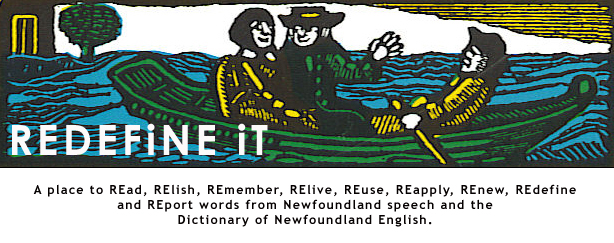Thanksgiving Fish Dinner
Get yourself a good-sized round fish. The size needed depends on how many hands you plan to feed and their appetites. A rounder might feed one or two, but a larger fish is needed for a crowd.
Head your fish, then gut him in one of three ways:
1. Split him down the belly. This makes cleaning easier, but adds to the sewing.
2. Split him in the back and take out part of the sound-bone to get at the offal, leaving his belly intact.
3. Don’t split him at all, but clean him through the hole where his head used to be. This option is best left to the highly skilled, because the fish must be awful clean before you stuff him.
Scrape your fish and take off his tail and fins. Wash him carefully in several waters and pat him dry inside and out with paper towels. Let him bide on a tray or cookie sheet until ready to stuff.
Make dressing as you would for turkey, chicken, turr, grouse or squid. The amount you need depends on the size of your fish. Roll sufficient day-old white loaf in your hands until fine crumbs form. Seasoning the crumb is highly subjective. Add in savory, salt, black pepper, butter, and fresh or dried minced onion and mix with your hands until it smells just right and holds its shape when you squeeze a small amount gently in your hand. Pack the dressing into your fish through his back, his belly or the hole where his head used to be. Don’t put in too much or you won’t be able to sew him up. He could also burst asunder while baking.
Once the dressing is in his gut, thread a darning needle with twine and sew up his back, belly, and neck hole, as required. You may want to put a small square of tinfoil inside the neck before you sew him up, similar to the treatment you give the over-sized arse of a stuffed turkey. This will keep every bit of dressing inside as he bakes. Once sown up, heave him in a greased roaster and surround him with chopped onions. Cut paper thin strips of fat pork or fat back, and lay them across the fish. Salt and pepper to taste, or to as much as your blood pressure will allow. Add a bit of water, cover the roaster and bake him in a hot oven (400 degrees) until done.
In the meantime, cook praties, carrot, turnip, greens or cabbage enough for all hands in your boiler with a small junk of watered salt beef. Cook until vegetables are fork tender, falling apart, or can be sucked through a straw, according to local tradition.
To serve, hoist the cooked fish onto a serving platter, making sure to leave the bits of fat pork and onion in the roaster. To keep the fish from breaking this must be done very carefully, using two or more metal spatulas and calling in help if needed. Lift out the cooked vegetables into serving bowls, keeping everything separate but the carrot and turnip. Put the beef on the platter with the fish. Leave the cooking water in the boiler. Make up gravy in the usual manner, using flour for thickening and incorporating the pork, onions and drippings. Add water from the boiler as needed. Stir up and cook your gravy in the roaster or use a dipper if preferred. Don’t forget the browning!
Place the platter with the whole stuffed cod in the middle of your dining table, surrounded by the bowls of vegetables and the dipper of gravy. Don’t count on leftovers but the bones and twine.
End the meal with cups of tea, berry pie, tinned cream, and yarns about how big fish used to be when you were youngsters.
Dictionary of Newfoundland English words used:
Arse
Awful
Berry
Bide
Boiler
Dipper
Fat back
Fat pork
Fish
Hands
Heave
Junk
Loaf
Offal
Pratie
Round
Rounder
Salt beef
Sound-bone
Split
Turr
TwineWater
Submitted by Bonnie Morgan to our Recipe Redux Contest and selected as a part of our alternative Thanksgiving Dinner Menu.
Sunday, October 12, 2008
Subscribe to:
Post Comments (Atom)





No comments:
Post a Comment